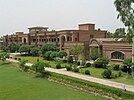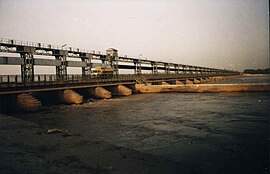Jhang
Jhang
جھنگ | ||
|---|---|---|
City | ||
Clockwise from top:
Shrine of Calling code 047 | | |
Jhang (جھنگ; Punjabi pronunciation:
Etymology
The historical name of the city and district is Jhang Sial.
History
The city of Jhang was built in 1288 by Rai Sial, a chief of the Sial tribe.[4][6][3] The Sial tribe, his kin, ruled over this region ever since then until the last Sial ruler of Jhang, Ahmad Khan (1812 to 1822) was defeated by Ranjit Singh after a fierce fighting.[3][7]
Under the collective rule of the Sial Khans of Jhang and other Sial sub-tribes such as the Rajbana and Bharwana, in the zenith of their power, the Sial country of Jhang extended up to the
Under the British Raj, the towns of Jhang and Mighiana, lying two miles (3.2 km) apart, became a joint municipality, then known as Jhang-Maghiana.[8]
Geography
Jhang Sadr is located at 31.27 latitude and 72.33 longitude and is situated at an elevation of 158 meters above sea level.
Jhang is situated at the East bank of Chenab which has confluence with Jhelum at Trimmu Barrage near the town of Athara Hazari. The city was endangered in the 2014 floods but it was not flooded as the flood water was redirected towards Athara Hazari.[9] there are three river in jhang such as chenab river jhelum river and river ravi is also touch with the boundary of District Jhang near Ahmadpur Sial. Maghiana lies on the edge of the highlands, overlooking the alluvial valley of the Chenab, while the older town of Jhang occupies the lowlands at its foot.[8]
Demographics
The population of city in 1998
| Religious group |
1881[11][12][13] | 1891[14]: 68 [15] | 1901[16]: 44 [17]: 26 | 1911[18]: 23 [19]: 19 | 1921[20]: 25 [21]: 21 | 1931[22]: 26 | 1941[10]: 32 | 2017[23] | ||||||||
|---|---|---|---|---|---|---|---|---|---|---|---|---|---|---|---|---|
| Pop. | % | Pop. | % | Pop. | % | Pop. | % | Pop. | % | Pop. | % | Pop. | % | Pop. | % | |
| Islam |
10,941 | 50.58% | 11,334 | 48.66% | 11,684 | 47.92% | 12,707 | 49.04% | 14,760 | 48.97% | 18,042 | 50.07% | 24,506 | 48.96% | 427,008 | 99.43% |
| Hinduism |
10,187 | 47.1% | 11,355 | 48.75% | 12,189 | 49.99% | 12,395 | 47.83% | 14,389 | 47.74% | 16,724 | 46.41% | 23,286 | 46.52% | 36 | 0.01% |
| Sikhism |
495 | 2.29% | 573 | 2.46% | 484 | 1.99% | 796 | 3.07% | 970 | 3.22% | 1,243 | 3.45% | 2,215 | 4.43% | — | — |
| Jainism |
0 | 0% | 0 | 0% | 0 | 0% | 4 | 0.02% | 7 | 0.02% | 0 | 0% | 5 | 0.01% | — | — |
| Christianity |
— | — | 28 | 0.12% | 25 | 0.1% | 12 | 0.05% | 13 | 0.04% | 26 | 0.07% | 39 | 0.08% | 1,836 | 0.43% |
| Zoroastrianism |
— | — | 0 | 0% | 0 | 0% | 0 | 0% | 0 | 0% | 0 | 0% | — | — | — | — |
| Judaism |
— | — | 0 | 0% | 0 | 0% | 0 | 0% | 0 | 0% | 0 | 0% | — | — | — | — |
| Buddhism |
— | — | 0 | 0% | 0 | 0% | 0 | 0% | 0 | 0% | 0 | 0% | — | — | — | — |
| Ahmadiyya |
1881pop | 0% | — | — | — | — | — | — | — | — | — | — | — | — | 561 | 0.13% |
| Others | 6 | 0.03% | 0 | 0% | 0 | 0% | 0 | 0% | 0 | 0% | 0 | 0% | 0 | 0% | 0 | 0% |
| Total population | 21,629 | 100% | 23,290 | 100% | 24,382 | 100% | 25,914 | 100% | 30,139 | 100% | 36,035 | 100% | 50,051 | 100% | 429,441 | 100% |
Administration
Jhang Saddar is the administrative center of Jhang Tehsil (a subdivision of the district). The tehsil itself is divided into 55 Union councils.[24]
Education
- Virtual University of Pakistan (Jhang Campus)
- Lahore College for Women University (Jhang Campus)
- University of Veterinary and Animal Sciences (Jhang Campus)
- Government Post Graduate College
- Chenab College Jhang
- University of Jhang
- Punjab Group of Colleges
- Superior Group of Colleges
- Dar-e-Arqam Schools
- Cambridge Grammar School
- Beaconhouse School System
- The City School
Notable people
Scientists
- Abdus Salam, first Pakistani Nobel Laureate (Physics).
- Yash Pal, Indian scientist.
- Har Gobind Khorana, Indian American biochemist
Politicians
- Khan Arif Khan Rajbana, former federal and provincial minister, honourable Chief Whip of All-India Muslim League and a close associate of the Quaid-e-Azam
- Syeda Abida Hussain, former Pakistani Ambassador to USA and Federal minister.
- Mian Muhammad Azam, former member of the Provincial Assembly of the Punjab.
- Faisal Saleh Hayat, former Interior Minister of Pakistan and FIFA official.
- Nazir Sultan, former Member National Assembly.
- Mahboob Sultan, Federal minister.
- Ghulam Bibi Bharwana, Member National Assembly.
- Najaf Abbas, former member of National Assembly and Provincial Assembly.
- Waqas Akram, former minister of state for Labour and Manpower
- Haq Nawaz Jhangvi, Pakistani cleric, founder of Sipah-e-Sahaba Pakistan and namesake of Lashkar-e-Jhangvi
- Azam Tariq, Pakistani politician, religious leader, member of national assembly, leader of sunni-Deoband Muslim organization 'Sipah-e-Sahaba Pakistan'[25]
- Masroor Nawaz Jhangvi, Pakistani Islamic cleric and politician, Member of Provincial Assembly (MPA) Punjab, son of Haq Nawaz Jhangvi
- Zahoor Ahmed Sajid, former Member of Provincial Assembly.
Police Officers
- Tariq Saleem Dogar, Former IGP Punjab
Sports personalities
- Aleem Dar, cricketer and umpire
- Ghulam Shabber, UAE cricket player
Literary personalities
- Majeed Amjad, Urdu poet
- Nasir Abbas Nayyar, Pakistani Urdu language columnist
- Ishtiaq Ahmad, Urdu fiction writer
Religious figures
- Sarwari QadiriSufi order
- Shah Jeewna, founder of Qalandariyya Sufi order
Business people
- Sheikh Waqas Akram, founder of Shalimar Transport
Sister cities
Jhang has one sister city:
References
- ^ a b "Pakistan: Provinces and Major Cities - population of Jhang city per 2017 census". Citypopulation.de website. Archived from the original on 29 June 2020. Retrieved 22 May 2023.
- ^ "Pakistan City & Town Population List". Tageo.com website. Retrieved 22 May 2023.
- ^ a b c d e Punjab Government (1883). Gazetteer Of The Jhang District. pp. Chap. II. — History. 27.
- ^ a b Wikeley, J. M. Punjabi Musalmans. Robarts - University of Toronto. Lahore Book House.
- ^ a b "Gazetteer - Punjab District Gazetteers, Jhang District, with Map, 1929 - South Asia Archive". www.southasiaarchive.com. Retrieved 22 September 2020.
- ^ a b "HISTORY OF JHANG". Jhang on Punjab Portal, Government of Pakistan website. Retrieved 22 May 2023.
- ^ "Government of Pakistan, Map of Jhang" (PDF).
- ^ a b Jhang District article in the Imperial Gazetteer of India, v. 14, pp. 125 - 134
- ^ Shamsul Islam (10 September 2014). "Panicked residents flee Jhang city". The Express Tribune (newspaper). Retrieved 22 May 2023.
- ^ a b "CENSUS OF INDIA, 1941 VOLUME VI PUNJAB". Retrieved 9 January 2024.
- JSTOR saoa.crl.25057656. Retrieved 31 March 2024.
- JSTOR saoa.crl.25057657. Retrieved 31 March 2024.
- JSTOR saoa.crl.25057658. Retrieved 31 March 2024.
- JSTOR saoa.crl.25318666. Retrieved 9 January 2024.
- JSTOR saoa.crl.25318669. Retrieved 9 January 2024.
- JSTOR saoa.crl.25352838. Retrieved 9 January 2024.
- JSTOR saoa.crl.25363739. Retrieved 9 January 2024.
- JSTOR saoa.crl.25393779. Retrieved 9 January 2024.
- JSTOR saoa.crl.25393788. Retrieved 9 January 2024.
- JSTOR saoa.crl.25394121. Retrieved 9 January 2024.
- JSTOR saoa.crl.25430165. Retrieved 9 January 2024.
- ^ "CENSUS OF INDIA, 1931 VOLUME XVII PUNJAB PART II TABLES". Retrieved 9 January 2024.
- ^ "Final Results (Census-2017)". Retrieved 27 January 2023.
- ^ Tehsils & Unions in the District of Jhang – Government of Pakistan Archived 12 February 2008 at the Wayback Machine
- ^ "Azam Tariq gunned down in Islamabad". 7 October 2003.
- ^ 1881-1941: Data for the entirety of the town of Jhang, which included Maghiana, Jhang Municipality and Jhang Civil Lines.[10]: 32
- ^ 1931-1941: Including Ad-Dharmis
External links
- Punjab Government (Jhang District profile) Archived
- Jhang Portal (in Urdu language)
- Jhang Portal (in English)





